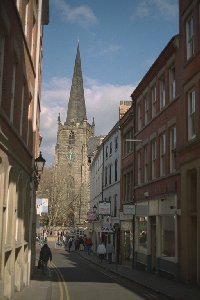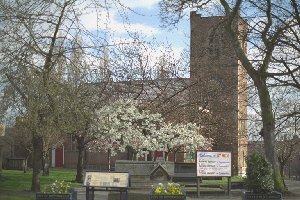
|
| |
A tour of old Nottingham - the French borough
This is a short photographic tour of Nottingham, from the Lace Market
down to the Castle. We continue with the French borough around the Castle.
|
Hounds Gate
 Hounds Gate is another of the ancient medieval streets of
Nottingham. Its name is a reminder of Nottingham's time as part of the Danelaw, for
"gata" was the Scandinavian term for street. At the bottom of Hounds Gate a
familiar church can be discerned. St Peter's and St Nicholas' were both founded to serve
the inhabitants of the French borough which grew up around the Castle. Hounds Gate runs
parallel to Castle Gate and leads from St Peter's, past the Salutation Inn and St.
Nicholas' Church, and up to the Castle entrance. It has been bisected by Maid Marian Way,
but our town planners have recently tried to make amends by installing a
pedestrian-controlled crossing. Hounds Gate is another of the ancient medieval streets of
Nottingham. Its name is a reminder of Nottingham's time as part of the Danelaw, for
"gata" was the Scandinavian term for street. At the bottom of Hounds Gate a
familiar church can be discerned. St Peter's and St Nicholas' were both founded to serve
the inhabitants of the French borough which grew up around the Castle. Hounds Gate runs
parallel to Castle Gate and leads from St Peter's, past the Salutation Inn and St.
Nicholas' Church, and up to the Castle entrance. It has been bisected by Maid Marian Way,
but our town planners have recently tried to make amends by installing a
pedestrian-controlled crossing.
|
|
 The third medieval church of Nottingham, situated
near the Castle. The original building was demolished by Colonel Hutchinson in 1643 at the
time of the Civil War, because snipers had used the tower as a vantage point for firing on
the Castle. The present fine brick building was constructed fairly recently, between 1671
and 1682. Its churchyard was once a secluded garden, but is now open to the traffic of
Maid Marian Way. It is fortunate to have an enthusiastic and evangelical congregation. The third medieval church of Nottingham, situated
near the Castle. The original building was demolished by Colonel Hutchinson in 1643 at the
time of the Civil War, because snipers had used the tower as a vantage point for firing on
the Castle. The present fine brick building was constructed fairly recently, between 1671
and 1682. Its churchyard was once a secluded garden, but is now open to the traffic of
Maid Marian Way. It is fortunate to have an enthusiastic and evangelical congregation.
St Nic's Church website
|
Castle Road
 Castle Road is a favourite spot for tourists and locals
alike, where al fresco living is possible for much of the year (weather
permitting). Opposite the Castle, and just up from the famous Trip to Jerusalem Inn and
the Brewhouse Yard museum, you can enjoy a quiet pint, a cup of coffee, or an ice cream
(according to taste) just a few minutes walk from the bustle of the City Centre and the
roar of traffic on Maid Marian Way. Castle Road is a favourite spot for tourists and locals
alike, where al fresco living is possible for much of the year (weather
permitting). Opposite the Castle, and just up from the famous Trip to Jerusalem Inn and
the Brewhouse Yard museum, you can enjoy a quiet pint, a cup of coffee, or an ice cream
(according to taste) just a few minutes walk from the bustle of the City Centre and the
roar of traffic on Maid Marian Way.
|
The Castle
 Not the abode of the Sheriffs of Nottingham, alas. The original
building was destroyed by Parliamentarians in 1651 at the end of the Civil War. The ruins
were cleared by the first Duke of Newcastle who built a ducal palace on the site. This
building lasted until the Reform Riots of 1831 when it was set on fire and left a roofless
ruin for over forty years - before it was restored and started a new life as England's
first municipal museum and art gallery, a rôle that it still performs today. However,
parts of the medieval castle are still visible round the edges - the remains of some
towers, as well as the gatehouse and some of the outer curtain wall. The large open area
in the photograph is the Middle Bailey. If you are visiting be sure to see Mortimer's
Hole, a steep stairway bored down through the sandstone on which the Castle is built, and
the system of caves and dungeons beneath the Castle. Not the abode of the Sheriffs of Nottingham, alas. The original
building was destroyed by Parliamentarians in 1651 at the end of the Civil War. The ruins
were cleared by the first Duke of Newcastle who built a ducal palace on the site. This
building lasted until the Reform Riots of 1831 when it was set on fire and left a roofless
ruin for over forty years - before it was restored and started a new life as England's
first municipal museum and art gallery, a rôle that it still performs today. However,
parts of the medieval castle are still visible round the edges - the remains of some
towers, as well as the gatehouse and some of the outer curtain wall. The large open area
in the photograph is the Middle Bailey. If you are visiting be sure to see Mortimer's
Hole, a steep stairway bored down through the sandstone on which the Castle is built, and
the system of caves and dungeons beneath the Castle.
|
Link to the English borough
Return to the Guides
contents page
|

 Hounds Gate is another of the ancient medieval streets of
Nottingham. Its name is a reminder of Nottingham's time as part of the Danelaw, for
"gata" was the Scandinavian term for street. At the bottom of Hounds Gate a
familiar church can be discerned. St Peter's and St Nicholas' were both founded to serve
the inhabitants of the French borough which grew up around the Castle. Hounds Gate runs
parallel to Castle Gate and leads from St Peter's, past the Salutation Inn and St.
Nicholas' Church, and up to the Castle entrance. It has been bisected by Maid Marian Way,
but our town planners have recently tried to make amends by installing a
pedestrian-controlled crossing.
Hounds Gate is another of the ancient medieval streets of
Nottingham. Its name is a reminder of Nottingham's time as part of the Danelaw, for
"gata" was the Scandinavian term for street. At the bottom of Hounds Gate a
familiar church can be discerned. St Peter's and St Nicholas' were both founded to serve
the inhabitants of the French borough which grew up around the Castle. Hounds Gate runs
parallel to Castle Gate and leads from St Peter's, past the Salutation Inn and St.
Nicholas' Church, and up to the Castle entrance. It has been bisected by Maid Marian Way,
but our town planners have recently tried to make amends by installing a
pedestrian-controlled crossing. The third medieval church of Nottingham, situated
near the Castle. The original building was demolished by Colonel Hutchinson in 1643 at the
time of the Civil War, because snipers had used the tower as a vantage point for firing on
the Castle. The present fine brick building was constructed fairly recently, between 1671
and 1682. Its churchyard was once a secluded garden, but is now open to the traffic of
Maid Marian Way. It is fortunate to have an enthusiastic and evangelical congregation.
The third medieval church of Nottingham, situated
near the Castle. The original building was demolished by Colonel Hutchinson in 1643 at the
time of the Civil War, because snipers had used the tower as a vantage point for firing on
the Castle. The present fine brick building was constructed fairly recently, between 1671
and 1682. Its churchyard was once a secluded garden, but is now open to the traffic of
Maid Marian Way. It is fortunate to have an enthusiastic and evangelical congregation. Castle Road is a favourite spot for tourists and locals
alike, where al fresco living is possible for much of the year (weather
permitting). Opposite the Castle, and just up from the famous Trip to Jerusalem Inn and
the Brewhouse Yard museum, you can enjoy a quiet pint, a cup of coffee, or an ice cream
(according to taste) just a few minutes walk from the bustle of the City Centre and the
roar of traffic on Maid Marian Way.
Castle Road is a favourite spot for tourists and locals
alike, where al fresco living is possible for much of the year (weather
permitting). Opposite the Castle, and just up from the famous Trip to Jerusalem Inn and
the Brewhouse Yard museum, you can enjoy a quiet pint, a cup of coffee, or an ice cream
(according to taste) just a few minutes walk from the bustle of the City Centre and the
roar of traffic on Maid Marian Way. Not the abode of the Sheriffs of Nottingham, alas. The original
building was destroyed by Parliamentarians in 1651 at the end of the Civil War. The ruins
were cleared by the first Duke of Newcastle who built a ducal palace on the site. This
building lasted until the Reform Riots of 1831 when it was set on fire and left a roofless
ruin for over forty years - before it was restored and started a new life as England's
first municipal museum and art gallery, a rôle that it still performs today. However,
parts of the medieval castle are still visible round the edges - the remains of some
towers, as well as the gatehouse and some of the outer curtain wall. The large open area
in the photograph is the Middle Bailey. If you are visiting be sure to see Mortimer's
Hole, a steep stairway bored down through the sandstone on which the Castle is built, and
the system of caves and dungeons beneath the Castle.
Not the abode of the Sheriffs of Nottingham, alas. The original
building was destroyed by Parliamentarians in 1651 at the end of the Civil War. The ruins
were cleared by the first Duke of Newcastle who built a ducal palace on the site. This
building lasted until the Reform Riots of 1831 when it was set on fire and left a roofless
ruin for over forty years - before it was restored and started a new life as England's
first municipal museum and art gallery, a rôle that it still performs today. However,
parts of the medieval castle are still visible round the edges - the remains of some
towers, as well as the gatehouse and some of the outer curtain wall. The large open area
in the photograph is the Middle Bailey. If you are visiting be sure to see Mortimer's
Hole, a steep stairway bored down through the sandstone on which the Castle is built, and
the system of caves and dungeons beneath the Castle.